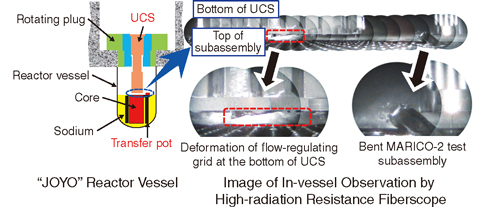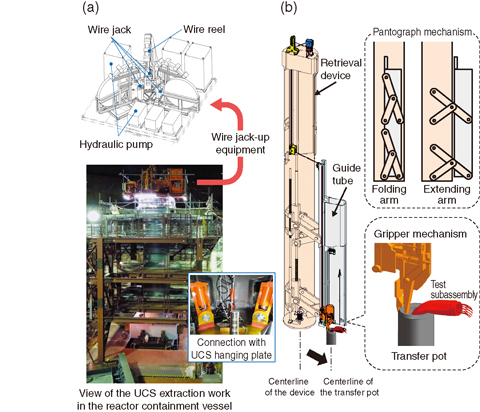
Fig.7-2 Occurrence of an obstacle in the reactor vessel

Fig.7-3 Flow of the UCS replacement and MARICO-2 test subassembly retrieval work

Fig.7-4 An example of a result of technological development
The experimental fast reactor “JOYO” needed restoration work including the replacement of the upper core structure (UCS) and retrieval of the bent test subassembly of the material test rig with temperature control (MARICO-2) due to a failure in the disconnecting and unloading work of the MARICO-2 test subassembly in 2007 (Fig.7-2). About 5300 man-days were spent on this restoration work and it was completed in December 2014. The maximum individual dose and the collective effective dose were controlled to be very low, approximately 0.25 mSv and 1.6 man-mSv, respectively.
The restoration work was conducted as shown in Fig.7-3. “JOYO” is a sodium-cooled fast reactor (SFR) in service, and hence, the equipment used for the task had to be capable of withstanding high temperatures (sodium temperature is around 200 ℃) and high doses of radiation (components are highly radioactive due to high neutron flux) and it was required to maintain the argon cover gas boundary. Various techniques were developed throughout the study, and the following are introduced as representative examples: (1) UCS jack-up equipment for replacement and (2) MARICO-2 test subassembly retrieval device. In the process of development, mock-up tests were conducted to confirm the functions of the equipment and device in the manufacturer’s factory. The data and knowledge obtained by the tests supported the implementation of various techniques and operation methods.
(1) Since exchanging the UCS during the lifetime of the reactor had not been considered during its design, the UCS jack-up equipment has a very precise monitoring capability to check the levelness of the UCS and the applied load to avoid mechanical interference with the surrounding structure and to detect contact and load abnormality quickly on the assumption that there is not much clearance. Furthermore, the state of the UCS could not be observed visually because the UCS with a high dose had to be jacked-up into a large, thick iron cask, as shown in Fig.7-4(a). Hence, this equipment has a stop system interlocked with the load monitoring.
(2) The MARICO-2 test subassembly retrieval device was installed in a removal hole for the UCS. The location of a gripper is adjusted by a remotely operated pantograph mechanism, as shown in Fig.7-4(b). The MARICO-2 test subassembly is gripped and lifted up with the transfer pot by the retrieval device. In the design of this device, temperature-resistant materials were selected and the change in size of this long mechanism due to thermal expansion was carefully considered. Moreover, multiple countermeasures were taken to prevent accidental fall of the transfer pot in the retrieval operation.
When performing maintenance and repair work in an SFR, unique technical developments different from those for a light water reactor are required due to the abovementioned environmental conditions. Considering this, the success of this restoration work involving in-vessel repair for the radioactive, large, and damaged components applying SFR maintenance techniques is a remarkable achievement throughout the world. The knowledge and experience gained from this project will be useful for upgrading the maintenance and repair technology for SFRs in the future.
<Previous: 7 Research and Development of Fast Reactors | Next: 7-2 >